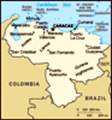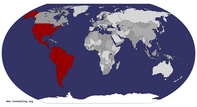Advertisement
Published: August 15th 2007
We were told that Caracas was big, ugly, unfriendly and dangerous. I am sure it is all those things but we went along determined to make the best of our time there.
We were staying at the Hotel Floresta at Altamira. We had an 8th floor room with a great view. And a fridge!
Our first job on arriving was to book a hotel near the airport for the night of the 30th. We had a very early flight and were warned that the road to the airport was dangerous at night. Only trouble was that because it was Copa America and the weekend a lot of places were full. Some we couldn't get through to and the online booking system failed for others. What a hassle! About to give up we finally got through to one and booked the night. But at $200 US, this would be a real treat!
We spent a whole day sight seeing down the center of town. We decided to take the metro, avoiding the heavy traffic and the hassle of a taxi. There are only a few lines and we needed the one running along the length of the city. And
it was only 500 Bs each. It is a modern, clean metro, not too far underground, each station with its own character. Just have to watch your stuff, same as any other metro in the world.
We got off at La Hoyata and our first stop was the Museum Foundation of John Boulton (not the one from 'The Bill'), on the 11th floor of a big ugly building on Sur 3 just down from Av Universidad. We signed in at reception and the guy at the desk said it was open so we went on up. The door was locked. Ringing the bell, a lady came and opened the door and told us it was closed. I attempted to ask if it was closed all day in spanish, at which time she ushered us in. The museum director (or perhaps the foundation director) introduced herself and in basic english told us that the museum was moving to a new location near Panteon Nacional. It would be open October-ish. She was very nice and showed us the ceramics that were still on display but we didn't walk around as the floor was littered with boxes. Mr Boulton was a trader
who settled in Venezuela and his descendants still live there.
Next we visited the house where Simon Bolivar was born. It was nice and free. The interior had been entirely restored but it seemed to the point where it was unlikely to bear any resemblance to what it looked like when he was alive. In the 1920s (I think) they put up some huge paintings in the 2 front rooms depicting events in his life. It was still very pretty. Looking up from the courtyard you are confronted by the contrasts of Caracas. The few colonial houses in the neighbourhood are surrounded by modern edifices, some ugly residential buildings and the 'Bank of Venezuela', a high rise of dark glass. The house is just north of Av Universidad in Norte 1.
Next door is another colonial building containing the Museo Bolivariano. All to do with Bolivar and the Independence. Of interest was Bolivar's shoes, shirt and uniform. It made you realise what a short, skinny guy he was. And there are also original letters from Bolivar.
Next we walked around the corner to the main square, Plaza Bolivar. Another leafy but not so fantastic plaza. We visited
the Museo Sacro de Caracas, next to the cathedral. For this we paid $2000 bolivars each. And it was good. Altars and gold objects and garments. Best of all there were explanations in english. The building is 19th century and was built as a college of some description to get around some anti-religious law by the government at the time. Not sure of the details. It backed onto a chapel where Bolivar's family rested. The chapel is a hotch-potch of bricks, having been patched up many times. You can also visit a crypt with bishops tombs and a communal grave (bones removed). No guides bothered us at all so far.
We popped our heads in the cathedral. There was a service so we didn't stay. A fairly austere interior. Not overly grand, a nice humble place of worship. We tried to find the city museum on the other side of the square but there seemed to be some trouble outside so we didn't try too hard. Walking a block south we found the Church of San Francisco which was more glitzy inside than the previous. Attached was the Palacio de la Academias. We had learnt in the Religious Museum
that after independence 6 of the 7 convents in town were destroyed because catholosism (or the churches) was seen as a symbol of spanish rule. The Palacio was the one that was spared. And it is very beautiful. We walked around what must be the presidents house, lots of security and flags.
Bit of a trek to the Panteon Nacional but it was necessary to see where the big man was interred after seeing his birthplace. A former church, there was a couple of security guards. The guy who waved us in had his key in his ear, digging around for something. There are a number of tombs and memorials but Bolivar was in the place of the altar. A pretty sarcophogus (the old one was on display at the Museo Bolivariano) and a flash memorial.
On the return trip on the Metro I got a very friendly ticket man. In spanish I asked for tickets but the guy didn't hear me and he said in english 'Where are you going?'. I told him Altamira and added 'para dos', to which he said 'you speak spanish!' and then he asked me where I came from. Very cheerful and
chatty. He wasn't at all concerned about the huge queue forming behind me.
The next day we said goodbye to Cameron, our faithful truck, and waved off the people continuing on the next leg of the Dragoman trip. It was a little sad and weird not to be with the group. We trotted off the Hotel Eurobuilding Express, the expensive hotel we booked near the airport. Actually, it was right next to the airport and we could watch the planes take off and land from our big room with 2 king size beds and a wide screen TV and a bath and a coffee maker ... oh the luxury ... and a microwave ... bit odd. The double glazing was very effective. The planes just sounded like a faint hum in the distance. The hotel was smaller than expected but it earned its 5 stars with a posh interior, the fantastic room and good service. We lounged by the pool and enjoyed and a great dinner in their restaurant including a very fruit bottle of Venezuela red wine. We slept well.
Arriving at the airport for our early flight we thought it a little odd that there were
no Port of Spain flights on the board. With no one at the Aeropostal desk we finally got hold of a supervisor. About 10 of us had been booked on a flight that didn't exist. It would be flying the same time tomorrow. After trying to get us there by the some other route and failing, the airline did book us into a hotel not far away. We spent 4 hours at the airport only to leave again. 7 of us went to the hotel. Ourselves, 2 Bolivians, a Colombian, a Mexican, and a shy guy from Trinidad. The Bolivians were very interesting. Criminal consultants, they were off to speak at a money laundering conference in Trinidad. They would now be very late. I have already mentioned these guys in a previous blog ... they were robbed at gun-point on the way from the airport to Caracas the night before. Taking the cheaper taxi, the taxi pulled over and was surrounded by 4 other cars. They were then told to pay up or be kidnapped or killed. They were still shaken by the experience and appreciated the opportunity to talk about it. And we were pleased that we decided not to travel in the wee small hours to the airport. The evening involved steak and Copa America football. We had a nice time with our multi-national group. And the hotel was basic but cool. The Hotel Santiago is 15 minutes north of the airport on the coast and has a beautifully decorated bar with broken tiles and mirrors on the walls, a white cave-like ceiling and lots of decorations.
The next day we spent 2 hours in the check-in queue before being told our flight was going to be delayed for 4 hours. Aeropostal paid for our breakfast and gave us flight vouchers worth US$100 each. Not that we will ever be using them again. We heard that Aeropostal was not a government airline and the government was making sure they paid for their mistakes and delays. We met a strange englishman at the gate. Had lived in Caracas for 20 something years, raved about the youth orchestra, told us Port of Spain was really dangerous and said nice things about the government. Seemed slightly mad.
We were happy to finally leave Caracas.
Advertisement
Tot: 0.151s; Tpl: 0.012s; cc: 22; qc: 112; dbt: 0.1063s; 1; m:domysql w:travelblog (10.17.0.13); sld: 1;
; mem: 1.3mb










